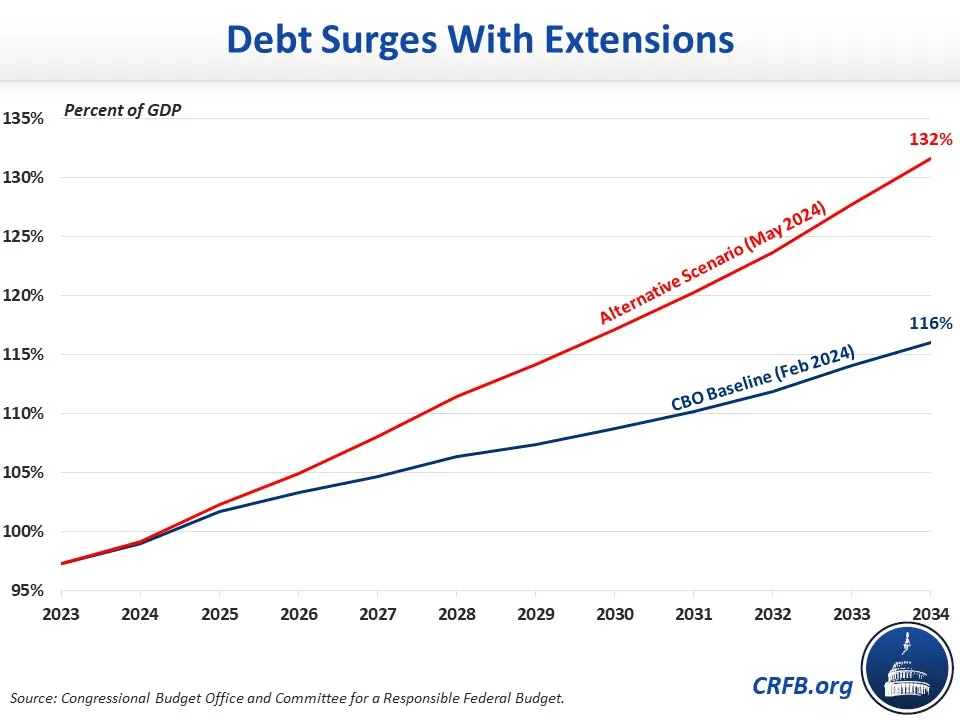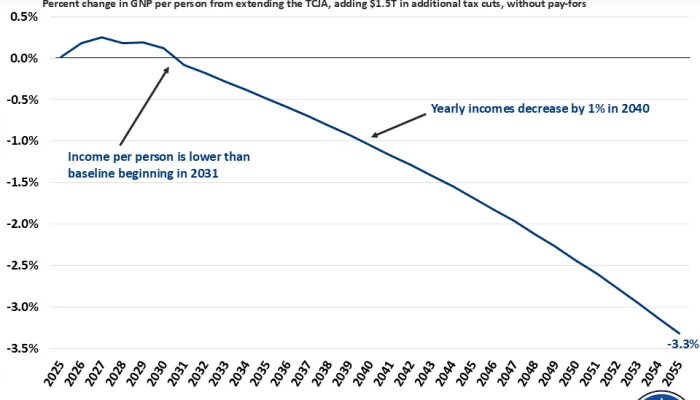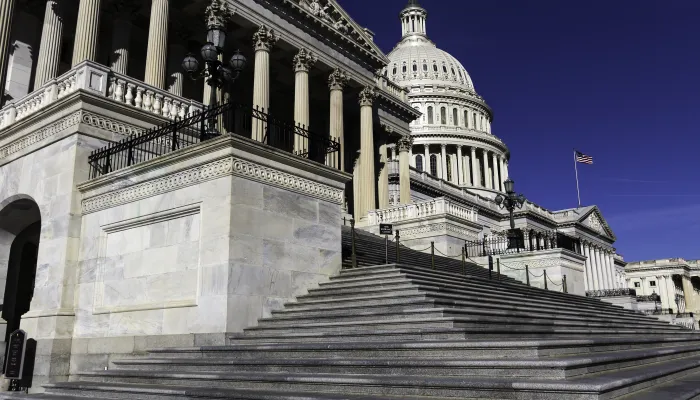Debt Surges With Extensions
Based on new estimates from the Congressional Budget Office (CBO), debt could reach 132 percent of Gross Domestic Product (GDP) by Fiscal Year (FY) 2034 under an alternative scenario where discretionary spending grows with the economy and expiring provisions, such as those from the Tax Cuts and Jobs Act (TCJA), are extended. Under this alternative scenario, deficits would reach 8.6 percent of GDP by 2034 and interest costs would reach 4.4 percent of GDP.

CBO’s February 2024 baseline projected debt under current law to reach 116 percent of GDP and deficits to reach 6.2 percent of GDP by FY 2034. Those projections were based on current law, meaning they do not include the fiscal impact of any future legislation or administrative actions, even for temporary policies that are routinely extended. They also assume appropriations will grow at the rate of inflation once the caps on discretionary spending included in the Fiscal Responsibility Act end after FY 2025.
In a recent analysis, CBO estimated the cost of extending a variety of expiring provisions and growing appropriations more rapidly.
Under an alternative scenario that incorporates most of these policy estimates as well as recently enacted spending increases, the federal government would borrow an additional $6.5 trillion through FY 2034 and bring the national debt to $54.8 trillion by the end of that year.
Most significantly, extending the expiring individual and estate tax provisions of the TCJA would add $3.4 trillion to the debt before interest. Extending or modifying various corporate tax changes would add another $551 billion. Growing discretionary spending with GDP instead of inflation – while also correcting a baseline quirk related to infrastructure spending – would cost nearly $1 trillion, and extending the expiring expansion of Affordable Care Act (ACA) insurance subsidies would cost another $335 billion. Extending various other measures would cost $217 billion. The net interest impact of all these policies would add an additional $834 billion to the debt.
Bridge to Alternative Scenario (Debt in 2034)
| Billions | Percent of GDP | |
|---|---|---|
| Debt in 2034 under CBO Feb 2024 baseline | $48,300 | 116.0% |
| Incorporate Recently-Enacted Appropriations | $161 | 0.4% |
| Extend TCJA Individual Income Tax Provisions | $3,256 | 7.8% |
| Extend TCJA Estate Tax Cuts | $167 | 0.4% |
| Extend TCJA Bonus Depreciation | $378 | 0.9% |
| Cancel Certain TCJA Tax Changes | $172 | 0.4% |
| Grow Discretionary Spending with GDP | $1,237 | 3.0% |
| Remove Extrapolated One-Time Infrastructure Funding | -$267 | -0.6% |
| Extend Enhanced ACA Premium Subsidies | $335 | 0.8% |
| Extend Expiring Energy Credits | $128 | 0.3% |
| Extend Certain Other Expiring Tax Provisions | $89 | 0.2% |
| Net Interest | $834 | 2.0% |
| Increase in 2034 Debt under Alternative Scenario | $6,491 | 15.6% |
| Debt in 2034 under Alternative Scenario | $54,791 | 131.6% |
Sources: Congressional Budget Office and Committee for a Responsible Federal Budget.
Under this scenario, the budget deficit would grow from $1.5 trillion (5.3 percent of GDP) in FY 2024 to $3.6 trillion (8.6 percent of GDP) by 2034, compared to $2.6 trillion (6.2 percent of GDP) under current law. Interest costs would grow from $870 billion (3.1 percent of GDP) in 2024 to $1.8 trillion (4.4 percent of GDP) by 2034, compared to $1.6 trillion (3.9 percent of GDP) under current law.
This does not account for the economic impact of extensions, which might reduce or increase output but would almost certainly put significant upward pressure on interest rates and could help to accelerate a future debt spiral.
To be sure, this is only one possible scenario and it may not reflect how Congress acts in the future. Debt could be higher, as this scenario does not include potential costs related to reviving the full expensing of research and experimentation costs and assumes the TCJA’s base broadening is continued in full. But debt might also be lower, as this scenario assumes some provisions intended to be temporary – such as the Inflation Reduction Act (IRA) energy credits – are extended. It also assumes discretionary spending will grow faster than the likely need and that policymakers will extend the TCJA in full without any additional offsets.
Yet, even if future Congresses don't accrue any of the additional debt in the scenarios above, debt will still be on an unsustainable upward path.
With federal debt on track to break its record as a share of the economy in just four years, policymakers should be focused on slowing the accumulation of debt, not accelerating it. As CRFB president Maya MacGuineas recently noted, policymakers should not enact any tax or spending changes or extensions without offsets, and they should instead prioritize deficit reduction.
Our Build Your Own Tax Extensions tool, not yet updated for these latest figures, can help users develop a responsible approach for addressing these looming expirations.


